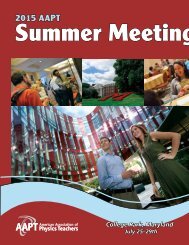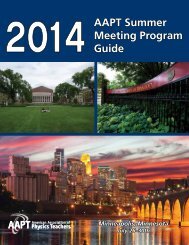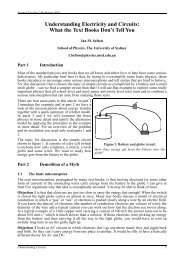final-program-12-23-14-3
final-program-12-23-14-3
final-program-12-23-14-3
Create successful ePaper yourself
Turn your PDF publications into a flip-book with our unique Google optimized e-Paper software.
S Y M P O S I U M<br />
on<br />
Physics<br />
Education<br />
AAPT Symposium on Physics<br />
Education and Public Policy<br />
Tuesday, January 6, 2–3:30 p.m. • Grande Ballroom C<br />
Policymakers formulate decisions everyday that impact curriculum, standards, funding, and many other<br />
aspects of physics education at all levels. AAPT works with a number of partners to keep policymakers<br />
informed on the views of physics educators and to suggest appropriate policy options within the Association’s<br />
sphere of influence. This session brings together individuals who play pivotal roles in helping to<br />
shape policies and who provide information to policymakers. We hope to provide a look at the process of<br />
policy making as well as actions you might make to contribute to decisions about policies affecting physics<br />
and STEM education.<br />
This Symposium is being partially sponsored by funds contributed to the Memorial Fund in memory of<br />
Mario Iona. Iona, a long-standing and dedicated AAPT member, was the first Chair of the Section Representatives<br />
and served on the AAPT Executive Board, was a column editor in The Physics Teacher, presenter<br />
at many national AAPT meetings, recipient of the Robert A. Millikan Award in 1986, and relentless<br />
champion of correct diagrams and language in textbooks. Contributions to the Memorial Fund provide<br />
support for many AAPT <strong>program</strong>s such as the Symposium.<br />
Shirley Malcorn<br />
Facilitator: Noah Finkelstein, Professor of Physics, University of Colorado at Boulder<br />
Speakers:<br />
Shirley Malcom, head of Education and Human Resources Programs at AAAS; smalcom@aaas.org<br />
Lee L. Zia<br />
Lee Zia, Deputy Division Director, National Science, Technology, Engineering, and Mathematics<br />
Education Digital Library (NSDL), NSF; lzia@nsf.gov<br />
Tuesday afternoon<br />
98<br />
Session IA: Post Deadline Papers<br />
Location: Nautilus Hall 1<br />
Sponsor: AAPT<br />
Date: Tuesday, January 6<br />
Time: 3:30–4:30 p.m.<br />
Presider: Ruth Howes<br />
IA01: 3:30-3:40 p.m. Bringing Research Experiences for<br />
Physics Teachers Back into the Classroom<br />
Contributed – Eric B. Botello, Judson Early College Academy, 8<strong>23</strong>0<br />
Palisades Dr., San Antonio, TX 78<strong>14</strong>8; ericb.botello@gmail.com<br />
Jitendra Tate, Nikoleta Theodoropoulou, Texas State University - San<br />
Marcos<br />
A summer Research Experience for Teachers can be both personally<br />
fulfilling and open your mind as an educator to the current research<br />
in physics. These professional developments should have a goal that<br />
brings the experience back to the classroom so that the students can<br />
be part of the experience as well. As part of two separate RETs at<br />
Texas State University–San Marcos offered through the Physics and<br />
Engineering Department, classroom instruction and overall environment<br />
was enhanced by offering activities not typical in a physics<br />
classroom. In the fall of 20<strong>14</strong>, a mini course in Nanotechnology was<br />
offered that highlighted STEM careers, a lab was conducted that<br />
highlighted properties of Nanotechnology, and a trip was made to the<br />
university to visit the facilities and experience the research first hand.<br />
The students became part of the RET by making the experiences a<br />
transformative event for the students and the educator.<br />
IA02:<br />
3:40-3:50 p.m. Exercises for Connecting Math Methods<br />
to Physics Problems<br />
Contributed – Gary Felder Smith College Smith College Clark Science<br />
Center Northampton, MA 0163-0001 gfelder@smith.edu<br />
Many physics curricula include a ”math methods” course, a brief<br />
introduction to a variety of math topics that students will use in later<br />
courses. Under the auspices of an NSF grant, we have developed a<br />
set of “motivational exercises” connecting each mathematical topic<br />
to the physical topics where it is applied. For example, Taylor series<br />
are introduced with an exercise (for homework or in class) in which<br />
students write down the equation of motion for an atom in a crystal<br />
and recognize that they can’t solve it. Then they are handed a linear<br />
approximation for the acceleration, plug in some numbers to verify<br />
that this new formula approximates the true acceleration well, and<br />
easily solve the resulting equation. At the end of the exercise they are<br />
told that in this chapter they will learn how to derive the approximation<br />
they just used.<br />
IA03:<br />
3:50-4 p.m. The Double Atwood Machine: A Multiple<br />
Device*<br />
Contributed – Paulo De Faria Borges, CEFET-RJ Rua Presidente<br />
Domiciano, #52 apto, 801 Niteroi RJ, RJ 24210-270 Brasil; pborges@<br />
cefet-rj.br<br />
Ricardo José Lopes Coelho, University of Lisbon<br />
The double Atwood machine problem is revisited. We will take<br />
account reference frames on fixed and mobile pulleys; coordinate<br />
transformations, weak and strong principle of equivalence, gravitational<br />
and inertial mass, and invariance of physics laws. To calculate<br />
accelerations on machine we will solve this problem from scratch,<br />
describing its dynamics in two different reference frames: inertial and<br />
WINTER MEETING<br />
JANUARY 3-6<br />
2015<br />
SAN DIEGO, CA






